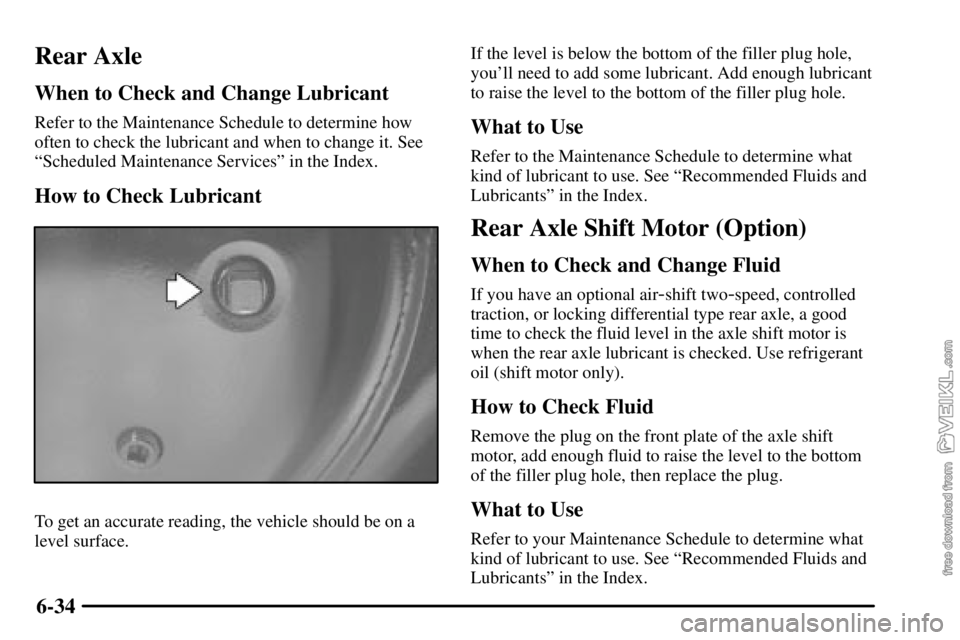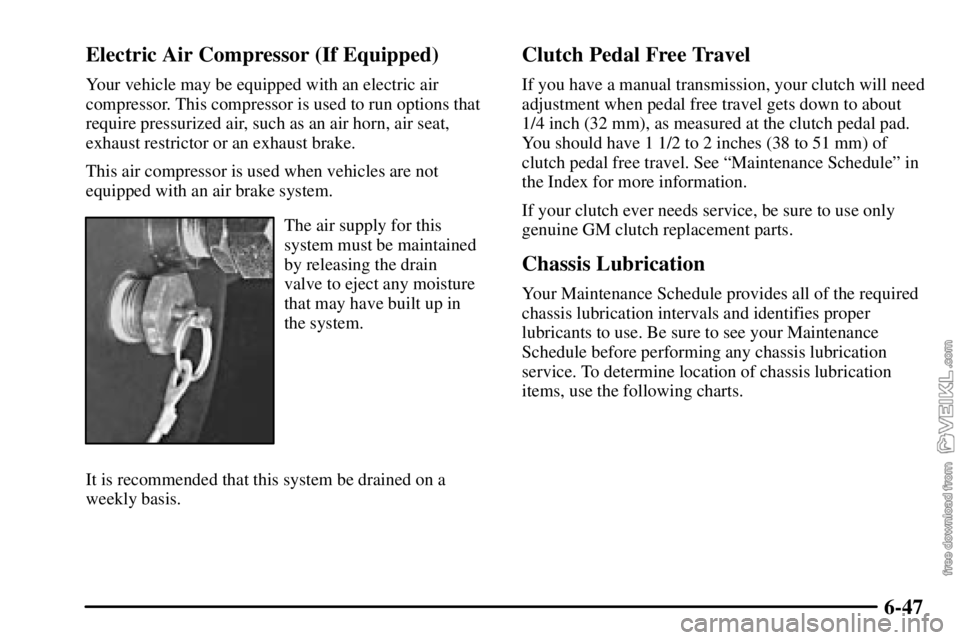Page 284 of 386

6-30 Engine Oil Additives
Don't add anything to your oil. The recommended oils
with the API service symbol are all you will need for
good performance and engine protection.
When to Change Engine Oil
Change engine oil and filter every 10,000 miles
(16 000 km) or every 12 months, whichever occurs first.
What to Do with Used Oil
Used engine oil contains certain elements that may be
unhealthy for your skin and could even cause cancer.
Don't let used oil stay on your skin for very long. Clean
your skin and nails with soap and water, or a good hand
cleaner. Wash or properly throw away clothing or rags
containing used engine oil. See the manufacturer's
warnings about the use and disposal of oil products.
Used oil can be a threat to the environment. If you
change your own oil, be sure to drain all the oil from
the filter before disposal. Never dispose of oil by putting
it in the trash, pouring it on the ground, into sewers, or
into streams or bodies of water. Instead, recycle it by
taking it to a place that collects used oil. If you have a
problem properly disposing of your used oil, ask your
dealer, a service station or a local recycling center
for help.
Engine Air Cleaner/Filter
Refer to the Maintenance Schedule to determine when to
replace the engine air cleaner/filter. See ªScheduled
Maintenanceº in the Index.
The engine air cleaner/filter
is located in the center of
the engine compartment.
Your gasoline or diesel engine has a restriction indicator
that lets you know when the engine air cleaner/filter
needs to be serviced.
Page 286 of 386

6-32
Automatic Transmission Fluid
When to Check
A good time to have it checked is when the engine oil is
checked. See your Allison Automatic Transmission
Operator's Manual to find out when to change your
transmission fluid and filters.
How to Check and What to Use
The Allison Automatic Transmission Operator's Manual
that came with the vehicle shows how to check the
automatic transmission fluid and what fluid to use.
Automatic Transmission External Filter
Your automatic transmission filter requires periodic
replacement.
Consult the Allison Automatic Transmission
Operator's Manual that came with the vehicle for
proper change intervals.
Manual Transmission Fluid
Refer to the Maintenance Schedule to determine how
often to check the lubricant and when to change it. See
ªScheduled Maintenance Servicesº in the Index.
Refer to the Maintenance Schedule to determine what
kind of fluid to use. See ªRecommended Fluids and
Lubricantsº in the Index.
When to Check
A good time to have it checked is when the engine oil is
checked. See your Maintenance Schedule to find out
when to change your transmission fluid.
Page 288 of 386

6-34
Rear Axle
When to Check and Change Lubricant
Refer to the Maintenance Schedule to determine how
often to check the lubricant and when to change it. See
ªScheduled Maintenance Servicesº in the Index.
How to Check Lubricant
To get an accurate reading, the vehicle should be on a
level surface.If the level is below the bottom of the filler plug hole,
you'll need to add some lubricant. Add enough lubricant
to raise the level to the bottom of the filler plug hole.
What to Use
Refer to the Maintenance Schedule to determine what
kind of lubricant to use. See ªRecommended Fluids and
Lubricantsº in the Index.
Rear Axle Shift Motor (Option)
When to Check and Change Fluid
If you have an optional air-shift two-speed, controlled
traction, or locking differential type rear axle, a good
time to check the fluid level in the axle shift motor is
when the rear axle lubricant is checked. Use refrigerant
oil (shift motor only).
How to Check Fluid
Remove the plug on the front plate of the axle shift
motor, add enough fluid to raise the level to the bottom
of the filler plug hole, then replace the plug.
What to Use
Refer to your Maintenance Schedule to determine what
kind of lubricant to use. See ªRecommended Fluids and
Lubricantsº in the Index.
Page 293 of 386

6-39
Power Steering Fluid
See your Maintenance Schedule for when to check your
power steering fluid.
How To Check Power Steering Fluid
Check your power steering fluid only when the engine is
warm. If the engine isn't warm, you probably won't get
an accurate reading.
If the fluid level is
between the MIN and
MAX marks, you have
enough. If you need
fluid, add only enough
of the proper fluid to
bring it into view in
the sight glass.If your power steering fluid level is low, this can cause
the BRAKE or service brake soon warning lights to
come on. If either light remains on after you have added
power steering fluid to the proper level, then shut off the
engine for 10 seconds. This should reset the brake
warning lights. If one or both lights stay on though, see
ªHydraulic Brake Warning Lightsº in the Index.
What to Use
To determine what kind of fluid to use, see
ªRecommended Fluids and Lubricantsº in the Index.
NOTICE:
When adding power steering fluid or making a
complete fluid change, always use the proper
fluid. Failure to use the proper fluid can cause
leaks and damage hoses and seals.
Page 301 of 386

6-47 Electric Air Compressor (If Equipped)
Your vehicle may be equipped with an electric air
compressor. This compressor is used to run options that
require pressurized air, such as an air horn, air seat,
exhaust restrictor or an exhaust brake.
This air compressor is used when vehicles are not
equipped with an air brake system.
The air supply for this
system must be maintained
by releasing the drain
valve to eject any moisture
that may have built up in
the system.
It is recommended that this system be drained on a
weekly basis.
Clutch Pedal Free Travel
If you have a manual transmission, your clutch will need
adjustment when pedal free travel gets down to about
1/4 inch (32 mm), as measured at the clutch pedal pad.
You should have 1 1/2 to 2 inches (38 to 51 mm) of
clutch pedal free travel. See ªMaintenance Scheduleº in
the Index for more information.
If your clutch ever needs service, be sure to use only
genuine GM clutch replacement parts.
Chassis Lubrication
Your Maintenance Schedule provides all of the required
chassis lubrication intervals and identifies proper
lubricants to use. Be sure to see your Maintenance
Schedule before performing any chassis lubrication
service. To determine location of chassis lubrication
items, use the following charts.
Page 308 of 386
6-54
Other Service Items
Fuel Filter (Gasoline Engines)
The steel fuel filter is located near the engine
compartment on the driver's side of the vehicle.
See your Maintenance Schedule for recommended
service intervals.If your vehicle is equipped with the optional Davco
spin
-on type filter, it is located on the driver's side
frame rail.
Fuel Filter (Diesel Engines)
If you have a diesel engine, your fuel filter is located in
the engine compartment on the driver's side of the
vehicle, or along the driver's side frame rail. See ªFuel
Filter Replacementº earlier in this section for further
information.
Also see your Maintenance Schedule for recommended
service intervals.
Page 319 of 386
6-65
CAUTION:
Rust or dirt on a wheel, or on the parts to which
it is fastened, can make the wheel nuts become
loose after a time. The wheel could come off and
cause a crash. When you change a wheel, remove
any rust or dirt from the places where the wheel
attaches to the vehicle. In an emergency, you can
use a cloth or paper towel to do this; but be sure
to use a scraper or wire brush later, if you need
to, to get all the rust or dirt off.
How Often to Check
Wheel tightness is so important you should have a
technician check nut tightness on all wheels with a
torque wrench after your first 100 miles (160 km), and
then 1,000 miles (1 600 km) after that. Be sure to repeat
this service whenever you have a tire removed or
serviced. See ªMaintenance Scheduleº in the Index for
further information.
Page 347 of 386
7-
7-1
Section 7 Maintenance Schedule
This section covers the maintenance required for your vehicle. Your vehicle needs these services to retain its safety,
dependability and emission control performance.
7
-2 Introduction
7
-4 Part A: Scheduled Maintenance Services
7
-5 Scheduled Maintenance7
-21 Part B: Owner Checks and Services
7
-27 Part C: Recommended Fluids and Lubricants
7
-30 Part D: Maintenance Record